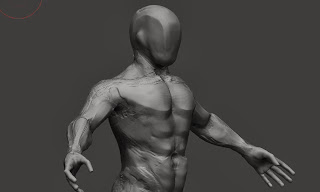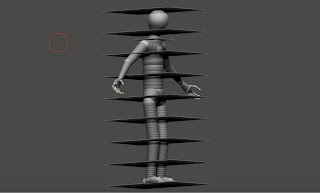For the arms I was able to sculpt it in alot of detail, even close to the escorche model provided in the digital sculpting book. However for a more aesthetically pleasing look, I smoothed it down with the clay tubes with low z-intensity and the smooth brush with a low curve. This meant however that alot of the muscles that I sculpted were lost in the overall sculpt. However the end result was a more convincing look.
I started by sketching in the deltoid and biceps, and then moved around the back to the triceps. The tricky part with the biceps was creating the 3 heads of the tricep muscle and having the deltoid wrap around all 3. I then moved on to creating a tendon that holds all three muscles together.
The forearm was by far the most challenging as it is made up of many muscles the way they wrap around the arm.
The elbow is composed of several bony landmarks. The main one however is the elbow itself which runs down to the ulna. The other two are the lateral and medial epicondyles. The forearm muscles can be simplified into two triangular shapes. From the back of the arm, you can see the extensors, on the front is the flexors. Together they radiate out from their insertions and curve around the forearm. The ulna bone serves as the dividing line between these two groups, the flexors and extensors.
I also always checked the sillouhette in flat colour mode to get the angle of the highest crest in the top and bottom profiles of the arm muscles. I also rotated the arms to give a more relaxed look to the body. Next i'll be focusing on the legs.
I'm also experimenting with different shaders and rendering which gives a different look and feel to the sculpt. Below is the video for the sculpt.
 |
| Arm from the back |
 |
| Arm from the front |
 |
| Top view |
 |
| Render with different shaders |



























